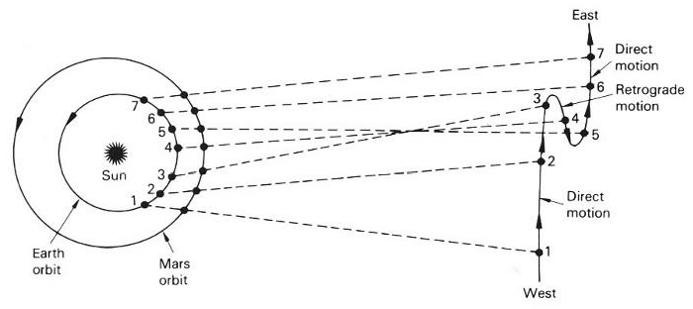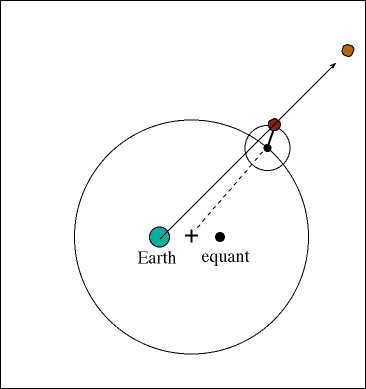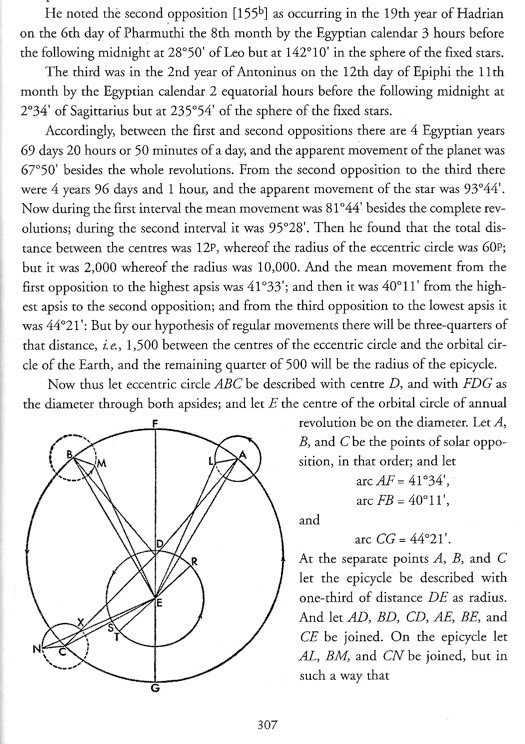by Angus Armitage
You’ve heard the story a million times: once upon a time people were stupid and superstitious and believed that the earth was the center of the universe and that the sun, moon, planets, and stars all circled around the earth. Then one day a smart scientist named Copernicus proved that the earth instead orbits the sun, and we all lived happily ever after.
If you know some of the details, you know that the sun-centered system was called the geocentric or Ptolemaic system, because it was expressed in its more detailed form by Ptolemy, a Greek scientist, around 150 CE. Perhaps you even know about epicycles, the weird and crazy idea that Ptolemy used to solve a serious problem with the geocentric system. The problem is best understood by explaining it in terms of modern understanding. This diagram shows the geometry of how we on Earth see Mars as we overtake it just before and after opposition, when Mars is 180º away from the Sun from our point of view:

Since the earth orbits the sun in one year but Mars takes just under two years to complete a revolution, the earth is moving faster than Mars. This means that, at opposition, an observer on Earth sees Mars moving backwards relative to its normal movement. Here’s a photomontage of an actual opposition:

Note that Mars is biggest and brightest at opposition because we’re closest to it then. By the way, the little dotted track just above it is Uranus also undergoing retrograde motion.
The ancients were fully aware of this phenomenon, but it made no sense in a geocentric system. If Mars was circling the Earth, why would it occasionally stop and reverse direction? The solution was the epicycle, a smaller orbital motion built into the orbit of Mars:
The idea here is that Mars moves in a little circle around a point that moves in a big circle around the earth. This does a pretty good job of explaining retrograde motion and it was possible to calculate the exact sizes required to fit the observational data nicely.
However, there were still a few anomalies in the data, which Ptolemy explained by adding a new concept: the equant. This provided a vague approximation of the ellipticity of the planet’s orbit. The idea was to shift the center of the planet’s orbit sideways a small distance from Earth, like so:

Between epicycles and equants, Ptolemy was able to obtain a pretty good fit to the observational data. When the Arabs revived astronomy centuries later, they added more observations and made some adjustments in the theory. Then Christian astronomers got into the act, and more observations piled up, and some incompatibilities with the data began to appear. People proposed various adjustments to the theory, adding epicycles on top of the epicycles, or other geometric tweaks.
This is where Copernicus entered the picture. He didn’t invent the heliocentric model; that had been conceived by some of the Greek astronomers, but had never gotten much traction. Copernicus’ contribution was to recalculate all the observational data in terms of the heliocentric system, returning results (orbital elements, the numbers that define the shape of an orbit) that could then be used to make predictions of future planetary positions.
The level of technical detail that Copernicus worked at is daunting. Here’s a page from a modern version of his book, De Revolutionibus:

Get a load of that diagram – Copernicus used thousands of diagrams like this in researching his work. All the calculations were carried out by hand. His methods were tedious in the extreme. One other thing: Copernicus assumed that all orbits were perfect circles. He had one foot in the future and one in the past.
Here’s the real kicker: the predictive powers of the Copernican system were no better than the modern version of the Ptolemaic system. His tables of planetary position predictions were just as good as the old ones. So what good was his system?
At the time, it had just one thing going for it: simplicity. Despite all the complexities evident in the above diagram, the Copernican system was conceptually easier to grasp than the Ptolemaic system. No epicycles, deferents, or equants were required to make it work. Occam’s Razor favored Copernicus, but more than a thousand years of tradition stood against him.
This is why the Copernican system did not conquer the world immediately. It wasn’t the opposition of the Church that held it back – at least not for the first 50 years. It was the horrible complexity of the thing that ultimately didn’t work any better than the old ways. Galileo’s telescopic observations swung opinion toward Copernicus. By showing that the moon was pockmarked with craters, he smashed the notion that the celestial spheres were perfect. His observations of the four Galilean moons moving around Jupiter proved that not everything orbited the earth. And his observations of the phases of Venus settled the matter once and for all. The Church tried to shut him up but in Northern Europe, where the Church’s writ did not run, Copernicus triumphed.
But do not underestimate the amount of hard work Copernicus had to do to make his theory work. The computations he carried out were truly humongous.
